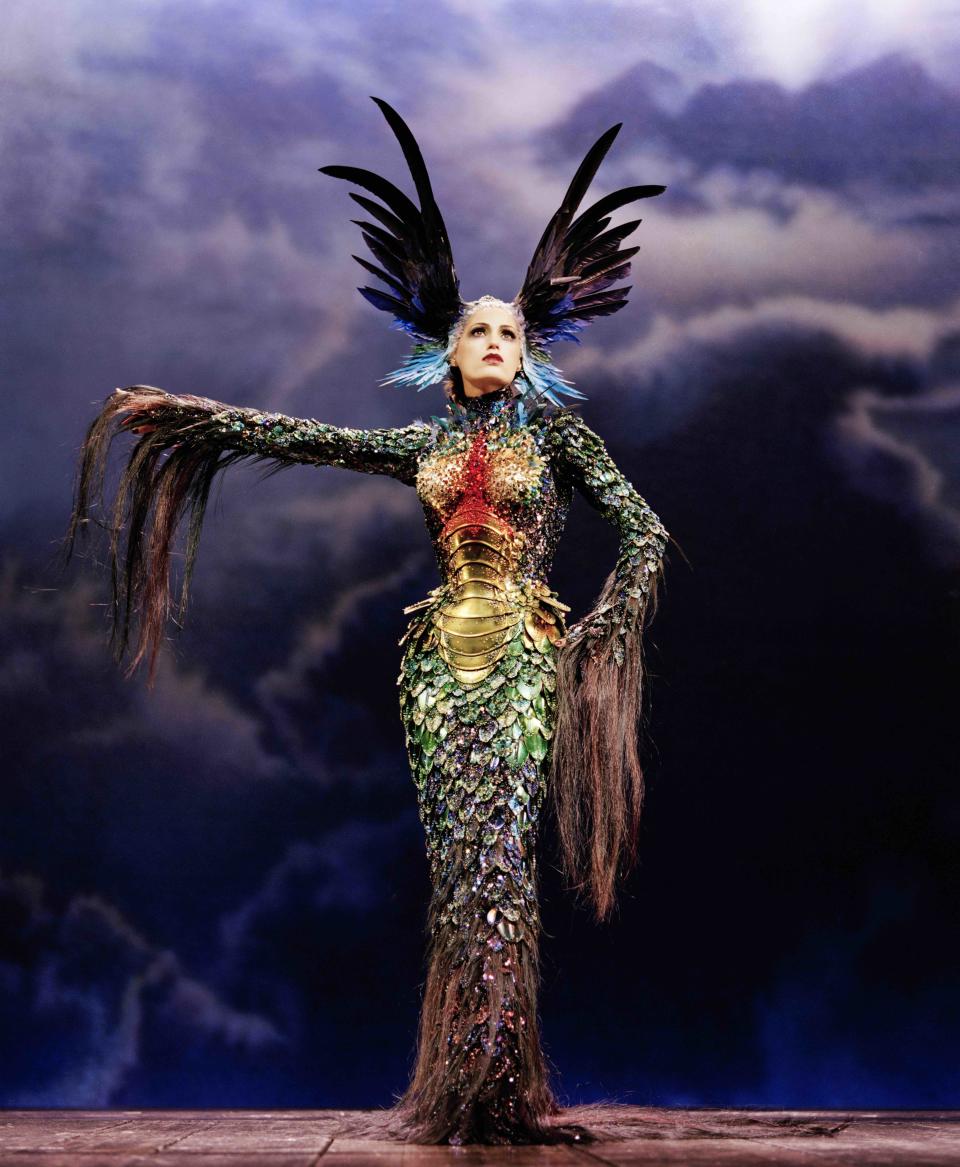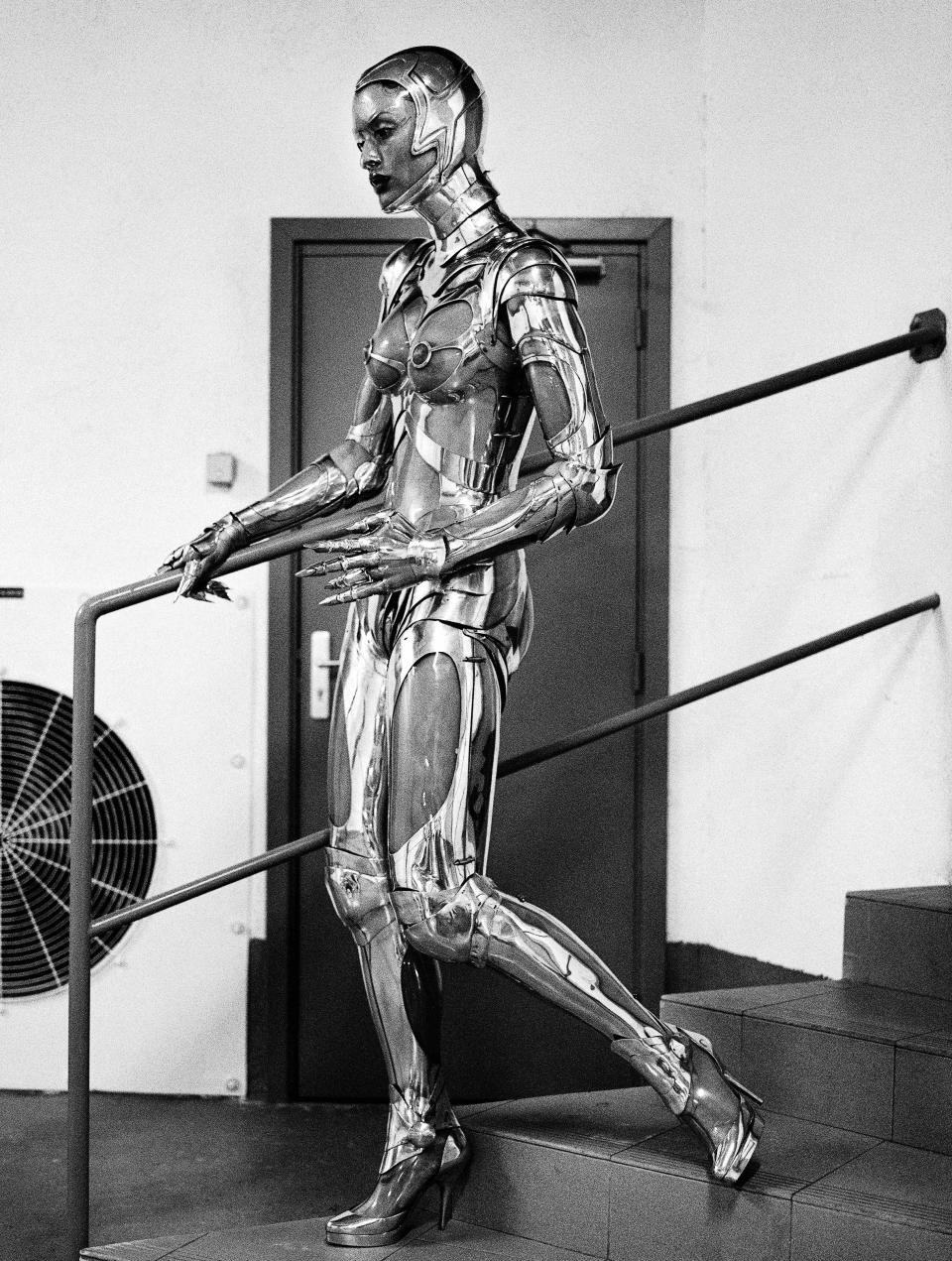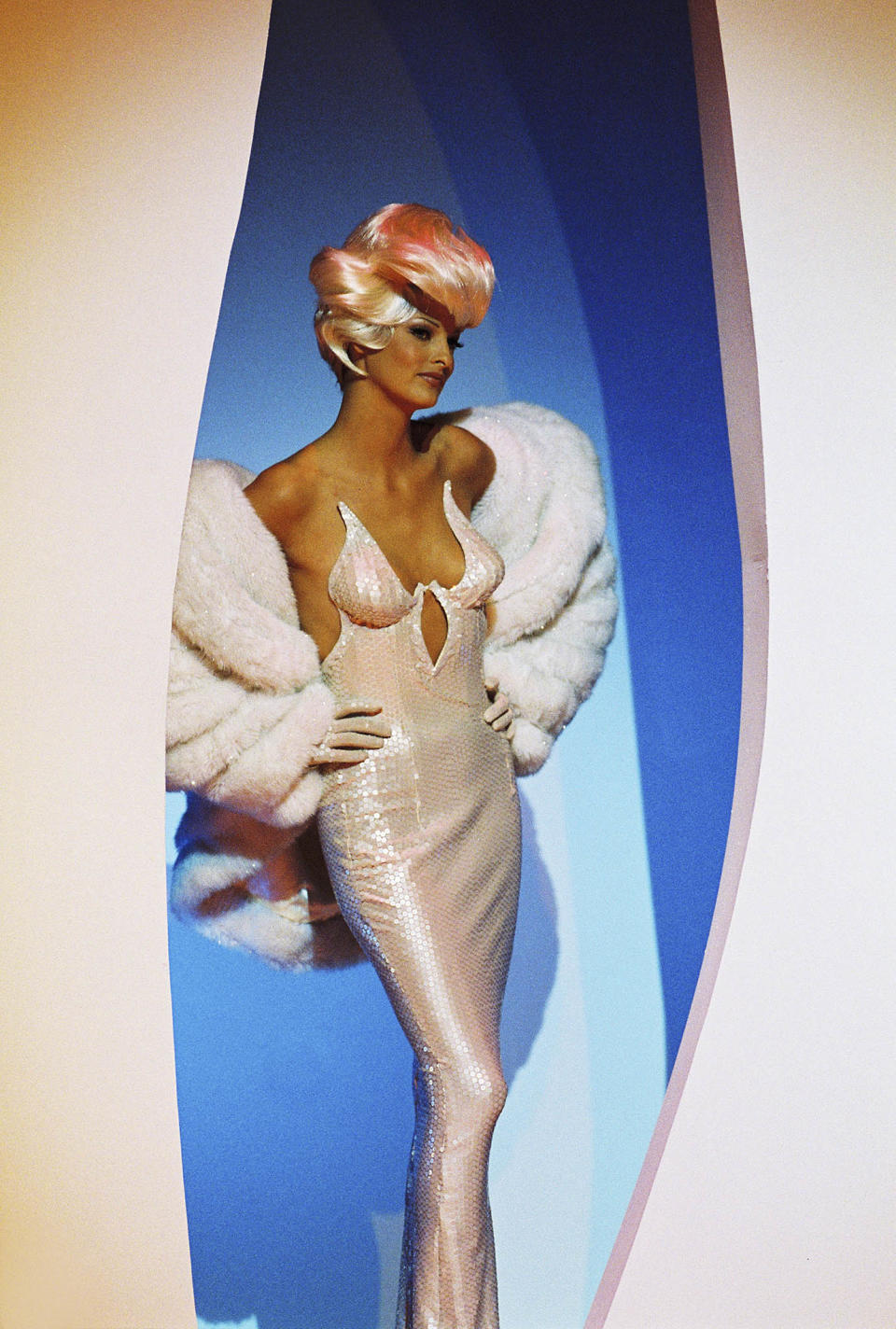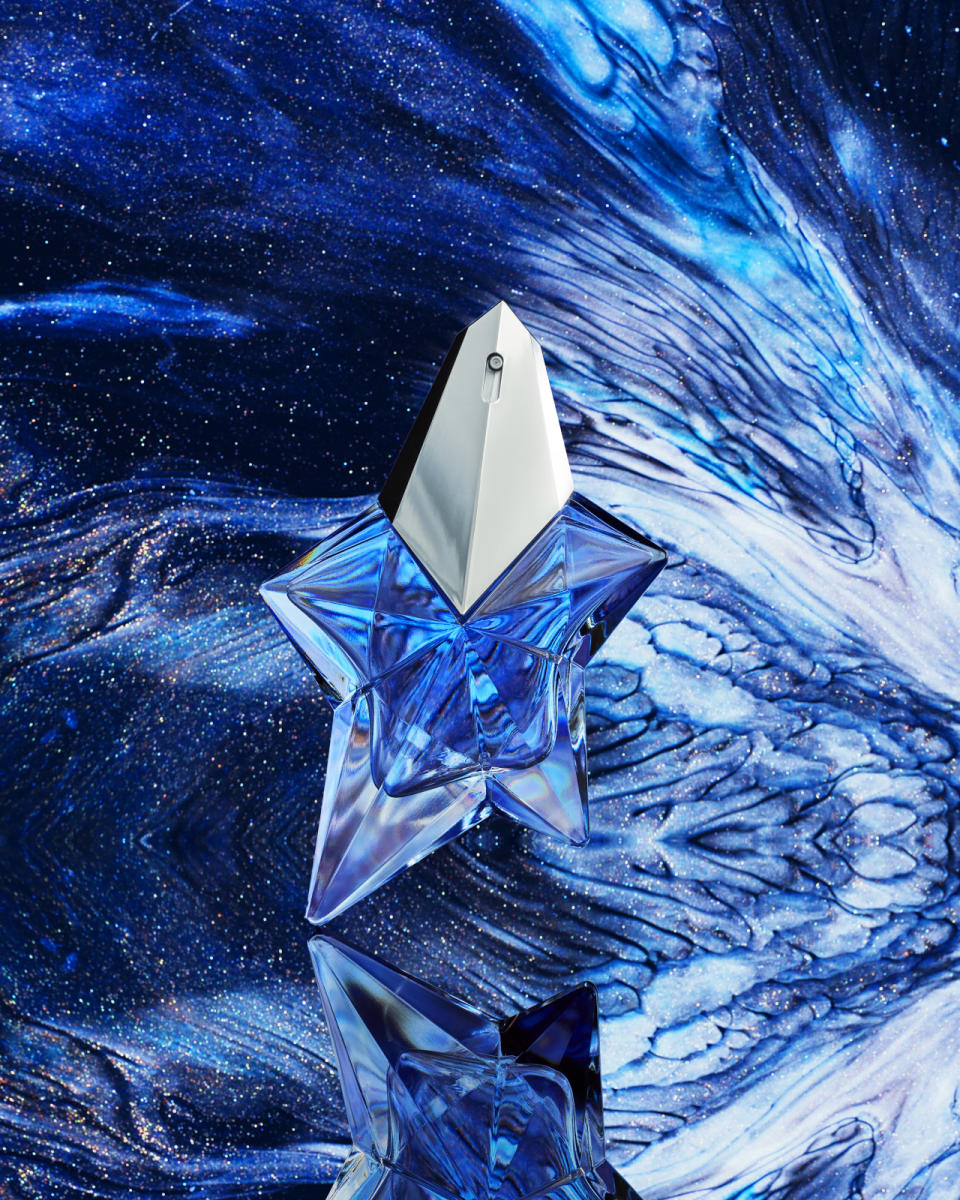Thierry Mugler Returns to Paris With First Major Retrospective
- Oops!Something went wrong.Please try again later.

PARIS — “It’s easier to see a Picasso in a museum than it is to see a Mugler couture dress.”
So says Thierry-Maxime Loriot, curator of the “Thierry Mugler: Couturissime” exhibition, set to open at the Musée des Arts Décoratifs in Paris on Thursday. The display, which made its debut at Montreal’s Museum of Fine Arts in 2019, has also made stops in Rotterdam and Munich, but the Paris leg marks the first major French retrospective of the designer’s work.
More from WWD
When Mugler retired from fashion in 2002, he stepped back from the industry to focus on fragrances and costume design, reverting to his birth name Manfred and embarking on a radical physical transformation through plastic surgery and bodybuilding.
Until the Montreal show, his work slowly disappeared from view. “There are 90 to 95 percent of pieces that had never been shown in a museum or loaned. Mugler simply did not want any exhibitions of his work,” Loriot explained.
With interest in his archival creations peaking, thanks in part to celebrities like Cardi B and Kim Kardashian West, the time has come for the designer to reclaim his legacy, said Olivier Gabet, director of the Musée des Arts Décoratifs.
“It’s worth taking a closer look at the landmark that was Mugler, because when you look at the date of some of his creations, you realize that his influence was considerable, as designers like John Galliano and Alexander McQueen attested,” he said.

Alan Strutt/Courtesy of Musée des Arts Décoratifs de Paris
The exhibition groups around 150 garments made between 1977 and 2014, along with a wealth of photographs from one of the seminal image-makers of the ‘80s, who reinvented the fashion show as Broadway-style spectacles starring the likes of Diana Ross and Jerry Hall.
“He was ahead of his time in many ways, from the phenomenon of celebrity-as-model to his relationship with the music world, and the cultural impact of fashion in contemporary society,” Gabet noted.
“He was one of those people who wasn’t formatted by a marketing strategy, though he was a master at communication,” he added. “It was intuitive, intelligent, artistic, animal sometimes, and I find that quite refreshing.”
Gabet believes the time has also come to revisit Mugler’s work in light of the evolution of the feminist movement. While some women objected to his extreme silhouettes inspired by insects, animals and robots, Mugler also had champions like the feminist art historian Linda Nochlin.
“A lot of women at the time felt that he was a designer that promoted female empowerment. I think that’s quite striking, because like all interesting designers, he’s extremely contradictory. It’s very ambiguous, because the same outfit can be read in different ways,” Gabet said.

Helmut Newton/The Helmut Newton Foundation, Berlin/Courtesy of Musée des Arts Décoratifs de Paris
Loriot said he wanted the exhibition to speak to younger visitors. “It was important for me not to re-create the past, but to ask what Mugler stands for in 2021,” he said.
“Even if his fashion wasn’t political, I think he was deeply committed to liberating women and to having an inclusive, humanist approach to his work. From the very beginning in the mid-‘70s, his runway shows were remarkable for their diversity, which was quite innovative at the time,” Loriot added. “He was very much inspired by power women. He wanted to make them even stronger. It was all about sculpting the body with clothes.”
On the fashion front, Mugler breathed new life into haute couture by working with materials like latex, chrome and Plexiglas. His seven-story building on the Rue aux Ours in Paris was a hive of experimental research, with seamstresses working alongside engineers and welders. He was one of the first designers to use fake fur, and a master of razor-sharp tailoring.
“Very few people know that Azzedine Alaïa was his studio assistant from the late ‘70s onward,” said Loriot, adding that Mugler was also the first to work with famed corset maker Mr Pearl.
From the beginning, the designer helped to create memorable pop cultural moments, including David Bowie in drag in the video for “Boys Keep Swinging”; Demi Moore’s black dress in “Indecent Proposal”; and the colorful skirt suits favored by Kim Cattrall’s character Samantha Jones in “Sex and the City.”
“It was an identity that was so unique because it wasn’t fashion, it wasn’t costume, it was something in-between that didn’t exist at the time,” Loriot said.
The designer crystallized the supermodel era with his 1992 video for George Michael’s “Too Funky,” starring the likes of Linda Evangelista, Eva Herzigová and Tyra Banks. The video also featured counterculture icons like actress Rossy de Palma and performance artist Joey Arias, but Mugler remained a lightning rod.
“His work was heavily criticized in the ‘90s. At the time, fashion was all about minimalism and grunge, and here he was showing women molded in latex with these incredible manes. Now suddenly, all the celebrities are fighting to wear those archival looks from the ’80s and ‘90s,” Loriot remarked.

Patrice Stable/Courtesy Photo
The first to reignite interest in his designs was Lady Gaga in 2009, with the video for “Paparazzi.” At around the same time, Beyoncé saw the “Superheroes: Fashion and Fantasy” exhibition at the Met’s Costume Institute and asked Mugler to design the costumes for her “I Am…” world tour.
For the 2019 Grammy Awards, Cardi B wore three Mugler looks, including one of the key outfits from his blockbuster 20th-anniversary collection in 1995: the Venus sheath gown with a huge pink satin shell-shaped crinoline, which is featured in the Paris exhibition. Kardashian West made waves with her wet-look latex corseted dress at the 2019 Met Gala, marking Manfred Mugler’s true comeback to fashion.
Thanks in part to these celebrity endorsements, the retrospective in Canada became the fifth most-visited exhibition in the 160-year history of the Montreal Museum of Fine Arts, Loriot said.
The Paris show, spread over two floors in the recently renovated Christine and Stephen A. Schwarzman Fashion Galleries, includes an entirely new section dedicated to Angel, the bestselling fragrance launched in 1992, with special diffusers for the scent and its key notes.
Sandrine Groslier, global brand president Mugler fashion and fragrances, has been working alongside the designer for 26 years, and said his impact on the world of fragrance was major.
“First of all, he brought a very disruptive approach to perfume by creating a new olfactory family, the gourmand category. To this day, nine out of 10 perfume launches fall into the gourmand category,” she said.
“There are only two or three new olfactory families created every century, so it’s a major phenomenon that profoundly transformed the industry. And when you look at the top rankings today, many of those fragrances are descendants of Angel,” she added.

Frederic Sofiyana/Behind The Obvious/Courtesy of Musée des Arts Décoratifs de Paris
Mugler also broke new ground with his fragrance fountain concept, allowing consumers to refill their bottles, thereby making savings as well as reducing waste. Lastly, he invited women to provide feedback and receive exclusive content through the Circle loyalty program that exists to this day at the company, now owned by beauty giant L’Oréal.
“Mugler is an addictive brand. I often say that it’s a love-or-hate brand. At any rate, it’s a brand that triggers emotions and that doesn’t leave you indifferent,” Groslier said.
While Mugler’s designs can be equally polarizing, Gabet is confident that the show will resonate with the public after a year of pandemic-related restrictions. “Mugler’s work intrinsically contains a strong message of confidence and enthusiasm, from a period when people believed in fashion and it was still very free,” he said. “This show is a must-see.”
Loriot, meanwhile, hopes the display will inspire young creatives by reminding them of an era when fashion wasn’t governed by large conglomerates. “His creations were extreme, and he himself describes himself as extreme,” he said. “He was someone who lived in his own world that he invented from scratch.”

Jean-Paul Goude/Courtesy of Musée des Arts Décoratifs
See also:
Kim Kardashian Calls Out Fast-fashion Brands for Designer Knock-offs
Cardi B Teams With Mugler for Another High-Fashion Grammys Moment
Willow Smith Fronts Mugler’s New Alien Goddess Scent
Best of WWD
Sign up for WWD's Newsletter. For the latest news, follow us on Twitter, Facebook, and Instagram.

